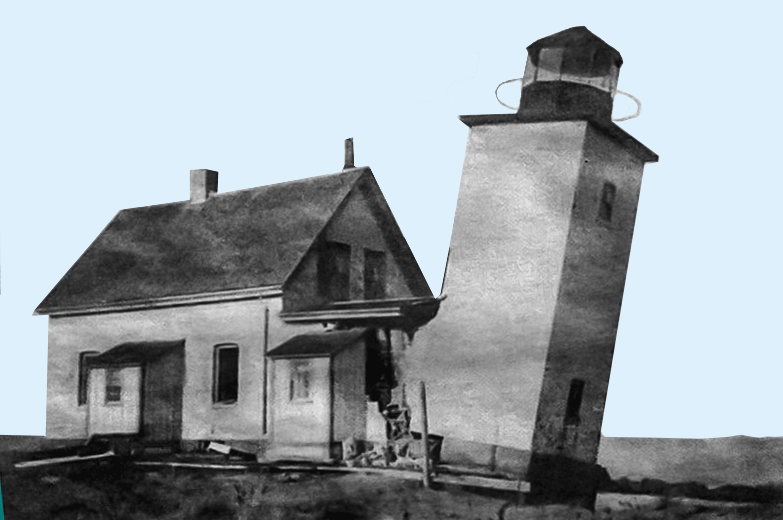Of Interest?
Leaning Tower of Billingsgate

Billingsgate Tower
Billingsgate Island
Early European settlers found an abundance of fish in Wellfleet Harbor. They named the area around the harbor Billingsgate after the Billingsgate Fish Market in London. At that time (the 17th century), Billingsgate Island covered an area of 60 acres (240,000 m2).
The Punonakanit people, members of the Wampanoag Federation, lived in the area and coexisted peacefully with European settlers. Their population greatly reduced by smallpox, the Punonakanits seem to have died out in the 19th century.
At its height in the early 19th century there were over thirty homes on Billingsgate Island; later it even had its own baseball team. The first lighthouse was built in 1822. After an 1855 storm divided the island in half, a second lighthouse was built on higher ground in 1858. The new structure was made of brick with a granite foundation; the foundation stones and a scattering of bricks can still be found on the shoal.
The island continued to erode away despite the addition of a sea wall in 1888 to protect the lighthouse. Early in the 20th century the last families moved off Billingsgate, leaving only the lighthouse keeper and a man who guarded the shellfish beds. Many of the houses on the island were floated across the harbor to Wellfleet on rafts to prevent their loss. The 1858 lighthouse was abandoned in 1915 and destroyed by a storm in December of the same year. The last light tower was torn down in 1922.
By the late 1930s or early '40s the island had been torn apart by coastal erosion. What remains is a sand bar exposed at low tide and littered with large granite blocks, a few bricks, and many shells.

Billingsgate Tower
Billingsgate Island
Early European settlers found an abundance of fish in Wellfleet Harbor. They named the area around the harbor Billingsgate after the Billingsgate Fish Market in London. At that time (the 17th century), Billingsgate Island covered an area of 60 acres (240,000 m2). The Punonakanit people, members of the Wampanoag Federation, lived in the area and coexisted peacefully with European settlers. Their population greatly reduced by smallpox, the Punonakanits seem to have died out in the 19th century. At its height in the early 19th century there were over thirty homes on Billingsgate Island; later it even had its own baseball team. The first lighthouse was built in 1822. After an 1855 storm divided the island in half, a second lighthouse was built on higher ground in 1858. The new structure was made of brick with a granite foundation; the foundation stones and a scattering of bricks can still be found on the shoal. The island continued to erode away despite the addition of a sea wall in 1888 to protect the lighthouse. Early in the 20th century the last families moved off Billingsgate, leaving only the lighthouse keeper and a man who guarded the shellfish beds. Many of the houses on the island were floated across the harbor to Wellfleet on rafts to prevent their loss. The 1858 lighthouse was abandoned in 1915 and destroyed by a storm in December of the same year. The last light tower was torn down in 1922. By the late 1930s or early '40s the island had been torn apart by coastal erosion. What remains is a sand bar exposed at low tide and littered with large granite blocks, a few bricks, and many shells.